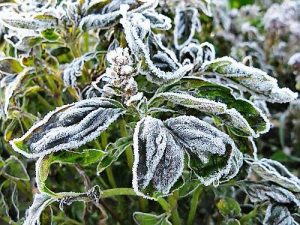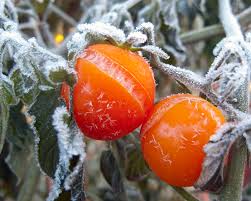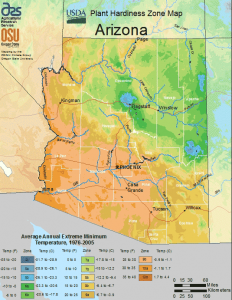by Ken Lain, the mountain gardener

Spring is here and the planting season is in full gear but there still is a chance of frost. Already customers have been to the garden center begging for tomato plants, the ultimate temperate, tropical plants. At even a hint of cold a tomato doesn’t merely shiver, it curls up in a frigid ball and dies!
 May 8th is the last frost date that is adhered to by local gardeners. After this date, locals start planting summer’s heat-loving plants like tomato, cilantro, and eggplant. However, many gardeners who adhere to tradition wait until Mother’s Day to plant their summer plants.
May 8th is the last frost date that is adhered to by local gardeners. After this date, locals start planting summer’s heat-loving plants like tomato, cilantro, and eggplant. However, many gardeners who adhere to tradition wait until Mother’s Day to plant their summer plants.
Feel free to plant frost-loving crops like lettuce, spinach, and onions along with all the colorful flowers of spring. Wait to plant frost-tender plants until after our May 8th last frost date.
If you are a part of Watters Garden Club you have received this column via email. If not, you might want to subscribe to the membership. A team of gardeners monitors our mountain spring weather closely and send both frost and freeze warnings when our gardens are at risk. If you garden in Northern Arizona and plant summer crops  like beans, pumpkins, and squash earlier than Mother’s day, you should pay close attention to weather alerts coming from Watters Garden Center. Let’s go over the possible weather warnings and how they affect our gardens.
like beans, pumpkins, and squash earlier than Mother’s day, you should pay close attention to weather alerts coming from Watters Garden Center. Let’s go over the possible weather warnings and how they affect our gardens.
Frost Advisory – when the temperature is expected to fall from 36 degrees F. to about 32 degrees F.
Freeze Warning – issued when there is at least an 80% chance that the temperature will hit 32 degrees F. or lower.
Hard Freeze – when the temperature falls below 28 degrees F.
Light Frosts – as air temperatures cools, the ground begins giving off heat. This is called radiational cooling. The clearer the sky, the more heat is given off.
For a frost to kill plants, the earth has to lose enough heat so that the freezing temperature occurs at ground level. If the ground is still warm, it is possible for frost to hover a bit above ground level. That’s what happens when frost kills the tops of your plants, but the lower portions remain green. This is a light frost.
Frosts tend to be short-term events that occur overnight or in the early hours of the morning. Hardy plants may come through unscathed, but tender plants can suffer some damage. It’s one of the reasons the USDA designates their hardiness zones by first and last expected frost dates.
Freezes usually are caused by advective cooling. Advection is the transference of some atmospheric condition like heat, humidity, or in this case, cold by the movement of an air mass. Think arctic blast. When one of these blows in, all tender plants are lost.
Freezes can be quick or they can linger. If they are cold enough, even a short freeze can do a lot of damage. Even hardy perennials can be killed back to ground level by a long, hard freeze. This is in mid-winter when the ground crunches when you walk on it!
It’s interesting to note that frost and freeze advisories are issued only during growing seasons, both spring and fall. If plants are dormant, these conditions are then referred to as cold weather.
Protecting Plants from a Frost
Cover Them – There’s nothing we can do to stop frosts and freezes from happening, but we can minimize the damage they do to our plants. When an advisory is issued, pull out the row covers or grab some sheets, blankets, pots, baskets, or whatever is at hand that will cover large plants or borders. If cold air cannot settle on plants, they should not be hurt.
Next day be sure to remove the coverings once the temperatures have warmed again; but keep them close at hand. You can be sure there will be more advisories to com!.
Water Them – It may sound counterintuitive, but water can insulate. Wet soil can retain 4 times more heat than dry soil. Water sprayed directly on plants forms a layer of ice that insulates the plants underneath it. Spraying only works for a frost. Don’t push your luck and try this during a hard freeze.
Youtube on Protect Plants from Frost
Going into winter it is essential to keep plants, including trees and shrubs, well-watered until the ground has frozen. Plants may be dormant, but their roots are still active and need water. Once the ground has frozen hard, it’s time to protect marginally hardy plants by putting down a winter mulch, to keep the soil frozen. You don’t want repeated freezing and thawing to push the plant’s crown out of the ground.
Free Gardening Classes ~
March 31 @ 9:30 am – Advanced Container Design – The right container with the right plants can change a landscape space from so-so to stunning. Lisa Lain, owner of Watters Garden Center, has been creating container designs for decades. Her 3-step program can bring floral style to your garden. The class is free to onlookers, but the first 12 students to sign up will create their designs with Lisa’s professional guidance for a $35 fee (pots provided). Come ready to get your hands dirty and to leave with an eye-catchingly planted container!
April 7 @ 9:30 am – Drip Irrigation Design & Installs – April is time to get that irrigation system up and running. Learn the benefits of drip irrigation, new technologies, and how to set up a system or how to add a plant to an existing system. With the right irrigation, you can save water and have healthier plants. Don’t know how to install and run an irrigation clock? We’ll teach you! Watters’ bins of irrigation parts will be full in preparation for this class. Come early and bring a lawn chair; over 100 students attended this class the last time it was offered!
April 14 @ 9:30 am – Garden Advice that Works in the Mountains – Ready to start your garden but want a little help? This class will take an in-depth look at how to be successful when planting your garden paradise. We’ll discuss techniques for brighter, more beautiful gardens, and how to keep them healthy. Learn how to troubleshoot and combat problems like poor soil conditions, pests, and diseases that can frustrate any gardener, whether a master or a novice. Bring your notepad!
Open this link to see all of Watters gardening classes this spring.
Until next issue, I’ll be here at Watters Garden Center helping locals grow better gardens.
Ken Lain can be found throughout the week at Watters Garden Center, 1815 W. Iron Springs Rd in Prescott, or contacted through his web site at WattersGardenCenter.com or FB.com/WattersGardenCenter

